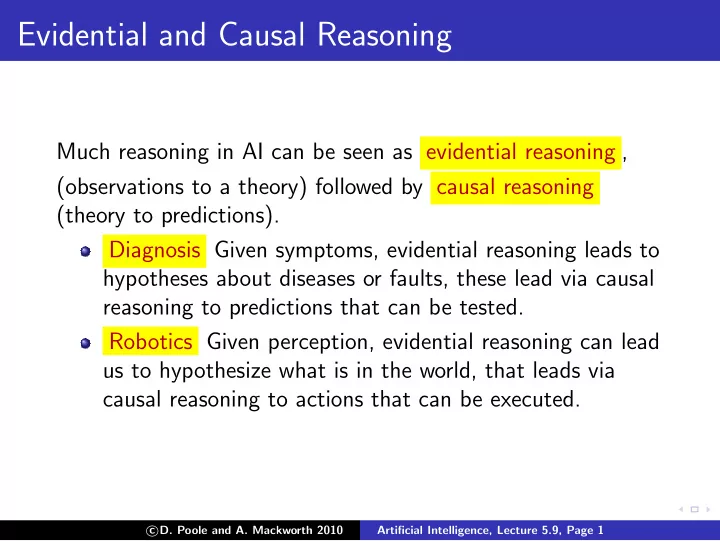

Evidential and Causal Reasoning Much reasoning in AI can be seen as evidential reasoning , (observations to a theory) followed by causal reasoning (theory to predictions). Diagnosis Given symptoms, evidential reasoning leads to hypotheses about diseases or faults, these lead via causal reasoning to predictions that can be tested. Robotics Given perception, evidential reasoning can lead us to hypothesize what is in the world, that leads via causal reasoning to actions that can be executed. � D. Poole and A. Mackworth 2010 c Artificial Intelligence, Lecture 5.9, Page 1
Combining Evidential & Causal Reasoning To combine evidential and causal reasoning, you can either Axiomatize from causes to their effects and ◮ use abduction for evidential reasoning ◮ use default reasoning for causal reasoning Axiomatize both ◮ effects → possible causes (for evidential reasoning) ◮ causes → effects (for causal reasoning) use a single reasoning mechanism, such as default reasoning. � D. Poole and A. Mackworth 2010 c Artificial Intelligence, Lecture 5.9, Page 2
Combining abduction and default reasoning Representation: ◮ Axiomatize causally using rules. ◮ Have normality assumptions (defaults) for prediction ◮ other assumptions to explain observations Reasoning: ◮ given an observation, use all assumptions to explain observation (find base causes) ◮ use normality assumptions to predict from base causes explanations. � D. Poole and A. Mackworth 2010 c Artificial Intelligence, Lecture 5.9, Page 3
Causal Network file_removed error_message fr_da da_em data_absent da_ast ld_da link_down another_source_tried di_ast data_inadequate Why is the infobot trying another information source? (Arrows are implications or defaults. Sources are assumable.) � D. Poole and A. Mackworth 2010 c Artificial Intelligence, Lecture 5.9, Page 4
Code for causal network error message ← data absent ∧ da em . another source tried ← data absent ∧ da ast another source tried ← data inadequate ∧ di ast . data absent ← file removed ∧ fr da . data absent ← link down ∧ ld da . default da em , da ast , di ast , fr da , ld da . assumable file removed . assumable link down . assumable data inadequate . � D. Poole and A. Mackworth 2010 c Artificial Intelligence, Lecture 5.9, Page 5
Example: fire alarm tampering fire smoke alarm leaving report � D. Poole and A. Mackworth 2010 c Artificial Intelligence, Lecture 5.9, Page 6
Fire Alarm Code assumable tampering . assumable fire . alarm ← tampering ∧ tampering caused alarm . alarm ← fire ∧ fire caused alarm . default tampering caused alarm . default fire caused alarm . smoke ← fire ∧ fire caused smoke . default fire caused smoke . leaving ← alarm ∧ alarm caused leaving . default alarm caused leaving . report ← leaving ∧ leaving caused report . default leaving caused report . � D. Poole and A. Mackworth 2010 c Artificial Intelligence, Lecture 5.9, Page 7
Explaining Away If we observe report there are two minimal explanations: ◮ one with tampering ◮ one with fire If we observed just smoke there is one explanation (containing fire ). This explanation makes no predictions about tampering. If we had observed report ∧ smoke , there is one minimal explanation, (containing fire ). ◮ The smoke explains away the tampering. There is no need to hypothesise tampering to explain report. � D. Poole and A. Mackworth 2010 c Artificial Intelligence, Lecture 5.9, Page 8
Recommend
More recommend